Bulldog Unveiling the Health Risks of a Beloved Breed
Introduction: The Bulldog Mystique
For decades, the Bulldog has held a special place in the hearts of dog lovers worldwide. With its iconic wrinkled face, sturdy build, and endearing personality, it’s no wonder why this breed is so beloved. However, behind the charming facade lies a tale of health risks and challenges that every prospective owner must be aware of. In this article, we delve deep into the health risks associated with Bulldogs, shedding light on important considerations for anyone considering bringing one of these iconic canines into their home.
The Genetic Quandary: Understanding Inherent Health Issues
One of the primary concerns with Bulldogs is their genetic predisposition to a variety of health problems. These issues stem from centuries of selective breeding, which has led to certain genetic traits being amplified, often to the detriment of the dog’s health. Chief among these concerns are respiratory issues, joint problems, skin conditions, and eye abnormalities.
Breathing Troubles: The Brachycephalic Conundrum
Perhaps the most well-known health issue plaguing Bulldogs is their brachycephalic nature, characterized by their shortened muzzle and flat face. While this distinctive feature adds to the breed’s charm, it also presents serious challenges when it comes to breathing. Bulldogs are prone to brachycephalic obstructive airway syndrome (BOAS), a condition that can cause breathing difficulties ranging from mild to severe. Symptoms include snorting, snoring, wheezing, and in extreme cases, even collapse. This respiratory issue not only affects the dog’s quality of life but also necessitates vigilant monitoring and potential medical intervention.
Joint Struggles: Navigating Orthopedic Challenges
Another significant health concern for Bulldogs is their susceptibility to orthopedic issues, particularly in their joints. Due to their compact, muscular build, Bulldogs are prone to conditions such as hip dysplasia and elbow dysplasia. These conditions occur when the joints do not develop properly, leading to discomfort, pain, and reduced mobility for the affected dog. While proper nutrition, exercise, and weight management can help mitigate the risk of joint problems, prospective owners must be prepared to address these issues throughout their Bulldog’s life.
Skin Sensitivities: Managing Dermatological Dilemmas
Bulldogs are also notorious for their skin sensitivities, which can manifest in a variety of ways. From allergies and irritations to infections and dermatitis, these skin issues can cause discomfort and distress for the affected dog. Factors such as environmental allergens, food sensitivities, and inadequate grooming can exacerbate these problems, making proactive skincare essential for Bulldog owners. Regular baths, proper diet, and routine veterinary care are crucial components of managing and preventing skin conditions in Bulldogs.
Eye Abnormalities: Protecting the Windows to the Soul
In addition to respiratory, orthopedic, and dermatological concerns, Bulldogs are prone to various eye abnormalities that can affect their vision and overall well-being. These issues can include cherry eye, entropion, ectropion, and corneal ulcers, among others. While some of these conditions may be congenital, others can develop over time due to factors such as genetics, environmental irritants, or injury. Early detection and prompt treatment are essential for preserving the Bulldog’s eye health and ensuring a good quality of life.
Conclusion: Navigating the Bulldog’s Health Journey
In conclusion, while Bulldogs undoubtedly possess many endearing qualities, it’s essential for prospective owners to be aware of the breed’s inherent health risks and challenges. From respiratory issues and joint problems to skin sensitivities and eye abnormalities, Bulldogs require attentive care and proactive management to thrive. By understanding these health concerns and taking proactive steps to address them, Bulldog owners can ensure that their beloved companions live happy, healthy lives for years to come. Read more about unhealthiest dog breeds




